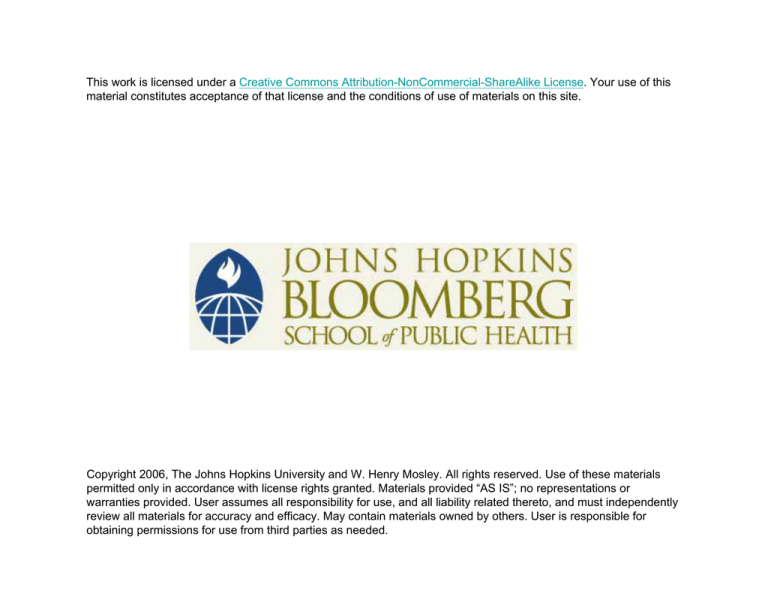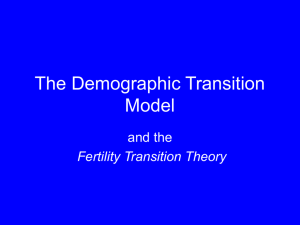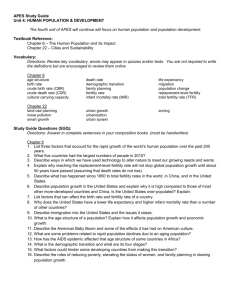
This work is licensed under a Creative Commons Attribution-NonCommercial-ShareAlike License. Your use of this
material constitutes acceptance of that license and the conditions of use of materials on this site.
Copyright 2006, The Johns Hopkins University and W. Henry Mosley. All rights reserved. Use of these materials
permitted only in accordance with license rights granted. Materials provided “AS IS”; no representations or
warranties provided. User assumes all responsibility for use, and all liability related thereto, and must independently
review all materials for accuracy and efficacy. May contain materials owned by others. User is responsible for
obtaining permissions for use from third parties as needed.
PFHS 380.665 FAMILY PLANNING POLICIES AND PROGRAMS
Intermediate Fertility Variables
A Framework for Fertility Analysis and Program Planning
W. Henry Mosley
A.
B.
Definitions:
1.
natural fertility
2.
proximate determinants
Intermediate Fertility Variables:
1.
Kingsley Davis and Judith Blake framework (1956)
2.
Variables used in reproductive models
a.
proportion of females married
b.
contraception
c.
induced abortion
d.
postpartum infecundability
e.
frequency of intercourse
f.
spontaneous intrauterine mortality
g.
permanent sterility
C.
Relative Importance of the Intermediate Variables
D.
The Bongaarts Model
E.
Applications of the proximate determinants model
1. decomposition of determinants of fertility for policy/program analysis
(Beijing case study)
2. setting goals and allocating resources for programs (SPECTRUM
computer model)
References
Required Reading:
Stover, J. Revising the proximate determinants framework of fertility.
What have we learned in the past 20 years? Studies in Family
Planning 29,3: 255–267, 1998.
Recommended Readings:
Bongaarts J. The fertility-inhibiting effects of the intermediate fertility variables.
Studies in Family Planning 13(6/7):179-189, 1982.
Bongaarts J. A simple method for estimating the contraceptive prevalence required
to reach a fertility target. Studies in Family Planning 15(4):184-190, 1984.
Bongaarts J, Frank O, Lesthaeghe R. The proximate determinants of fertility in
Sub-Saharan Africa. Population and Development Review 10(3):511-537,
1984.
Davis K, Blake J. Social structure and fertility, an analytic framework. Economic
Development and Cultural Change 4:211-23, 1956.
Wang S-X, Chen Y-D, Chen CHC, Rochat R, Chow LP, Rider R. Proximate
determinants of fertility and policy implications in Beijing. Studies in Family
Planning 18(4):222-228, 1987
2
Figure 1- Intermediate Variables Affecting Fertility*
I. Factors affecting exposure to intercourse
A.
Those governing the formation and dissolution of unions in the reproductive period
1.
Age of entry into sexual unions
2.
Permanent celibacy; proportion of women never entering sexual unions
3.
Amount of reproductive period spent after or between unions
a.
b.
B.
When unions are broken by divorce, separation or desertion
When unions are broken by death of husband
Those governing the exposure to intercourse within unions
4.
Voluntary abstinence
5.
Involuntary abstinence (from impotence, illness, and unavoidable but temporary
separations
6.
Coital frequency (excluding periods of abstinence)
II. Factors affecting exposure to conception
7.
Fecundity or infecundity, as affected by involuntary causes
8.
Use or non-use of contraception
a.
b.
9.
By mechanical and chemical means
By other means
Fecundity or infecundity, as affected by voluntary causes (sterilization, subincision,
medical treatment, etc.)
III. Factors affecting gestation and successful parturition
10.
Foetal mortality from involuntary causes
11.
Foetal mortality from voluntary causes
* Source:
Kingsley Davis and Judith Blake. Social Structure and Fertility: An Analytic
Framework, Economic Development and Cultural Change 4:211-35, 1956.
3
The BongaartsModel
TFR = TF x Cm x Cc x Ca x Ci
where: TFR = Total Fertility Rate
TF = Total natural Fertility rate
Cm = index of non-marriage
Cc = index of contraception
Ca = index of induced abortion
Ci = index of lactational infecundability
The value of each index ranges between 0 and 1; the lower the index value, the
greater the inhibiting effect of the variable. Each of these indices can be estimated
from survey data to assess the relative contribution of each of these proximate
determinants to the level of fertility.
Index of Non-Marriage
This index (Cm) expresses the effect of non-marriage in terms of reduction in fertility
per woman. By definition the index of non-marriage is the ratio between the total
fertility rate (TFR) and the total marital fertility rate (TM). That is:
Cm = TFR/TM
The proportion of women of reproductive age who are married can be used as an
approximation of Cm. That is:
Cm ~ MWRA/WRA
4
Index of Contraception
The index of contraception varies inversely with prevalence and use effectiveness of
contraception practiced by couples. The index of contraception is calculated
according to the following formula:
Cc = 1 - (1.08 x u x e)
Where: u = the overall proportion of married women currently
practicing contraception
e = the weighted average of contraceptive use
effectiveness using the proportions of current
contraceptive users of each method as weights
1.08 is a sterility correction factor
Index of Induced Abortion
Computation of the index of induced abortion requires first the estimation of the agespecific induced abortion rates from which one can calculate the total abortion rate
(TA). The total abortion rate is then used to estimate the total number of births
averted per woman (A) as follows:
A = b x TA
= .4(1 + u) x TA
where:
b = births averted per induced abortion
0.4 is an estimate of births averted per induced
abortion in the absence of contraception
u = the prevalence of contraception
After the total number of births averted per woman (A) is estimated, the index of
induced abortion is calculated as:
Ca = TFR/(TFR + A)
5
Index of Lactational Infecundability
The effect of lactational infecundability on fertility operates entirely through
modification of the birth interval. The equation to estimate the index of
infecundability is as follows:
Ci = 20.0/(18.5 + i)
where:
(18.5 + i) is the average birth interval with lactation
i = average duration of postpartum infecundability
This equation implies that 20 months is the birth interval in the absence of lactational
infecundability, allowing 7.5 months as waiting time to conception, 2 months to
account for spontaneous fetal wastage, 9 months for term gestation, and 1.5 months
for infecundability without lactation.
Estimation of Total Fertility
The total fertility rate is estimated from the indices according to the Bongaarts
model:
TFR = 15.3 x Cm x Cc x Ca x Ci
15.3 is an average estimate of TF that Bongaarts has derived based on data from
multiple studies. It is generally used for this analysis unless there is specific data
from the population under study to derive a better estimate, which is not usually the
case.
6







